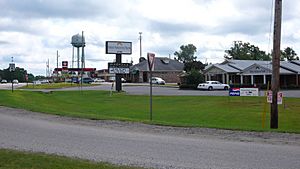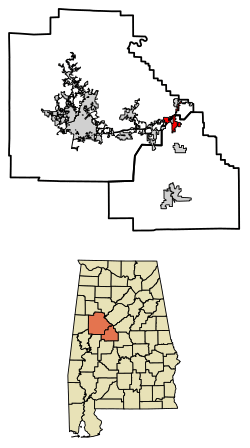Woodstock, Alabama facts for kids
Quick facts for kids
Woodstock
|
|
|---|---|
| Town of Woodstock | |

Business at the commercial center of Woodstock
|
|

Location of Woodstock in Bibb County and Tuscaloosa County, Alabama.
|
|
| Country | United States |
| State | Alabama |
| County | Bibb |
| Area | |
| • Total | 7.23 sq mi (18.72 km2) |
| • Land | 7.08 sq mi (18.34 km2) |
| • Water | 0.15 sq mi (0.38 km2) |
| Elevation | 571 ft (174 m) |
| Population
(2020)
|
|
| • Total | 1,472 |
| • Density | 207.85/sq mi (80.25/km2) |
| Time zone | UTC-6 (Central (CST)) |
| • Summer (DST) | UTC-5 (CDT) |
| ZIP code |
35188
|
| Area code(s) | 205, 659 |
| FIPS code | 01-83640 |
| GNIS feature ID | 2406913 |
Woodstock is a small town located in the state of Alabama, in the United States. It is found in two different counties: Bibb and Tuscaloosa.
The town was once called North Bibb. In 2000, people voted to change its name back to Woodstock, which was the name of an older community there. As of the 2020 census, about 1,472 people live in Woodstock.
Part of Woodstock in Bibb County is near the larger Birmingham city area. The part in Tuscaloosa County is close to the Tuscaloosa city area. A "metropolitan area" means a big city and the smaller towns and suburbs around it.
Contents
History of Woodstock
Early Days and Settlement
Woodstock was first settled in the 1820s. William Houston received a formal land grant for the area in 1826. The settlement grew along an old stagecoach route that connected Tuscaloosa to Huntsville.
The town got its name from Dr. J. U. Ray. He named it after his ancestors' home, Woodstock, England. His family had come to America from England, settling in Jamestown, Virginia.
Railroads and Industry
In the 1800s, Bibb County, where Woodstock is located, was important for Alabama's early industries. Factories that made iron goods used brown iron ore found nearby.
Woodstock became a busy center for railroads. In 1870, Dr. Ray built the first train station for the new Alabama-Chattanooga Railroad. Later, the Louisville and Nashville Railroad also came through, and both companies had stations.
In 1872, a train line was built to West Blocton to transport the large amounts of coal found there. Woodstock became a key place for storing and moving coal, iron ore, and cotton.
After the Civil War, rich iron ore deposits were mined. In 1872, Mr. Giles Edwards moved to Woodstock and built a large furnace to make pig iron. This is a type of iron used to make other iron products.
Mr. Edwards' son-in-law, James W. McQueen, later joined the business. He became the president of a major iron company in Birmingham.
Other Industries and Growth
Besides mining iron ore and coal, and farming, Woodstock also had a factory that made jugs. This factory used the large amounts of special clay found in the area. This clay was also used to make bricks, pots, and churns.
Many trains, sometimes as many as eight a day, stopped in Woodstock. They carried away the valuable goods produced there, and six of them even carried mail.
Woodstock was also home to a newspaper business in the 1800s. This newspaper later moved to Birmingham and became The Birmingham News, a very well-known newspaper.
Woodstock officially became a town in 1996, under the name "Town of North Bibb." Carl Jones was the first mayor. The town changed its name back to Woodstock on October 1, 2000.
Geography of Woodstock
Where is Woodstock Located?
Woodstock is in the northern part of Bibb County, Alabama. A small part of the town also reaches into Tuscaloosa County.
U.S. Route 11 runs northwest of the town center. This road leads northeast about 31 miles (50 km) to downtown Birmingham. It also goes west about 26 miles (42 km) to Tuscaloosa.
Interstate 59 is a major highway that passes northwest of Woodstock. The closest way to get onto Interstate 59 is by using Exit 97, which is north of the town.
Size of the Town
The U.S. Census Bureau states that Woodstock covers a total area of about 7.2 square miles (18.7 square kilometers). Most of this area, about 7.1 square miles (18.3 square kilometers), is land. The remaining small part, about 0.15 square miles (0.4 square kilometers), is water.
People of Woodstock
Population Changes Over Time
| Historical population | |||
|---|---|---|---|
| Census | Pop. | %± | |
| 2000 | 986 | — | |
| 2010 | 1,428 | 44.8% | |
| 2020 | 1,472 | 3.1% | |
| U.S. Decennial Census 2013 Estimate |
|||
The population of Woodstock has grown over the years. In 2000, there were 986 people living in the town. By 2010, the population had increased to 1,428 people. The most recent census in 2020 showed that 1,472 people lived in Woodstock.
Who Lives in Woodstock?
As of the 2020 census, there were 1,472 people living in Woodstock. These people made up 565 households, and 391 of these were families.
In 2010, there were 507 households in the town. About 34.3% of these households had children under 18 living with them. Many households, 61.9%, were married couples living together. About 10.3% of households had a female head with no husband present.
The average household size was about 2.79 people, and the average family size was 3.13 people.
Age Groups
In 2010, the population of Woodstock was spread across different age groups:
- 26.9% were under 18 years old.
- 8.3% were between 18 and 24 years old.
- 29.3% were between 25 and 44 years old.
- 25.4% were between 45 and 64 years old.
- 10.1% were 65 years old or older.
The average age in Woodstock was 35.7 years.
Notable People from Woodstock
- Ross F. Gray: He was a United States Marine who bravely served his country. He was given the Medal of Honor after he passed away, which is the highest military award. He was born in a nearby community called Marvel Valley.
- John B. McLemore: He was a very interesting person and a skilled horologist, someone who studies and makes clocks. He was the main person featured in a popular audio story called S-Town.
Culture and Media
The popular podcast S-Town, which was created by the team behind This American Life, is set and was recorded in Woodstock. This podcast brought a lot of attention to the town.
Images for kids
See also
 In Spanish: Woodstock (Alabama) para niños
In Spanish: Woodstock (Alabama) para niños



